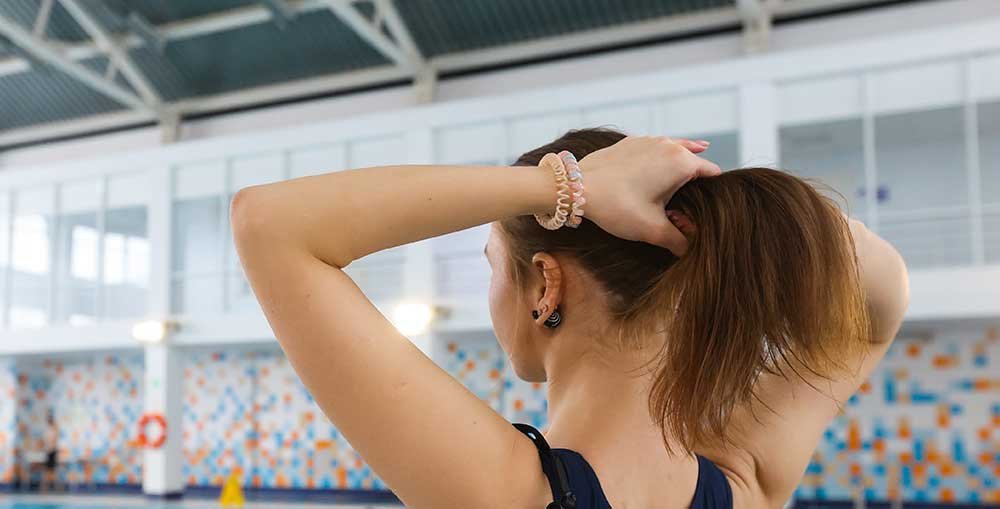Hair Extension Hydration: Can You Swim with Hair Extensions?
Swimming is a great way to beat the heat and get some exercise. However, for those who wear hair extensions, whether they can swim with them can be a concern. The good news is that it is possible to swim with hair extensions, but there are some things to keep in mind to ensure they stay in good condition.
One of the most important things to consider when swimming with hair extensions is your type of extensions. Semi-permanent or permanent hair extensions, like tape-ins, i-tips, or k-tips, are designed to look, feel, and behave like natural hair.
This means they can be washed, styled, and swam in like natural hair. However, clip-in hair extensions should be removed before swimming to prevent damage.
Another factor to consider is the type of water you will be swimming in. Chlorinated or salt water can be harsh on hair extensions and can cause damage if not properly cared for.
Wetting your hair with fresh water before swimming and applying a generous amount of conditioner to the extensions is recommended to avoid the bonds. Putting your hair in a braid or wearing a swimming cap can also provide extra protection.
Types of Hair Extensions
Hair extensions come in different types, each with its unique characteristics. Understanding the various types of hair extensions can help you decide which one is best for you. Here are some of the most common types of hair extensions:
Clip-in Hair Extensions
Tape-in Hair Extensions
Weave Hair Extensions
Micro-link Hair Extensions
Fusion Hair Extensions
Understanding Hair Extensions and Water
Hair extensions are a popular way to add length, volume, and style to hair. However, hair extensions require special care and attention when it comes to water. Here are some things to remember when considering swimming with hair extensions.
Protecting Hair Extensions Before Swimming
Before jumping into the water, taking precautions to protect hair extensions is important. This includes:
Keeping hair out of the water as much as possible
Wearing a swim cap or tying hair in a braid or ponytail to prevent tangling
Rinsing hair with clean water before entering the water to prevent chemical damage
Limiting Swim Sessions
While spending hours in the water may be tempting, limiting swim sessions when wearing hair extensions is important. Chlorine and salt water can damage hair extensions, causing them to become dry and brittle. Limiting swim sessions to no more than 30 minutes at a time is recommended.
Post-Swim Care
After swimming, taking care of hair extensions is important to prevent damage. This includes:
Shampooing hair as soon as possible to remove any chemicals or saltwater
Using a conditioner to help detangle hair and restore moisture
Drying hair gently with a towel or air-drying to prevent tangles and breakage
Taking these precautions and following proper care makes it possible to swim with hair extensions without causing damage.
Preparation Before Swimming with Hair Extensions
Swimming with hair extensions can be an enjoyable experience, but taking the necessary precautions to protect your extensions from damage is important.
Here are a few things to keep in mind before taking a dip:
Wet Your Hair with Fresh Water
Before jumping into the pool, wet your hair with fresh water. This will help prevent your extensions from absorbing as much chlorine or salt water as they would if they were dry.
Apply Conditioner
After wetting your hair, apply a generous amount of conditioner to your extensions, carefully avoiding the bonds. This will help protect your extensions from the harsh chemicals in the water.
Braid Your Hair
Braiding your hair before swimming can help prevent tangles and damage. It's also a good idea to wear a swim cap to provide extra protection.
Use the Right Hair Extensions
Not all hair extensions are created equal when it comes to swimming. Clip-in extensions are the most convenient type for swimming, as they can easily be removed before entering the water. If you have semi-permanent extensions, talk to your stylist about the best way to care for them before and after swimming.
Rinse and Dry Your Hair
After swimming, rinse your hair with fresh water to remove chlorine or saltwater. It's also a good idea to shampoo your hair as soon as possible to remove any remaining chemicals. Finally, dry your hair thoroughly to prevent any damage or tangling.
By taking these simple steps, you can help protect your hair extensions and enjoy swimming without worrying about damage or tangles.
Post-Swimming Care for Hair Extensions
After swimming with hair extensions, it is crucial to take proper care of them to maintain quality and prevent damage. Here are some tips for maintaining your hair extensions after swimming:
Rinse Thoroughly
After swimming, rinse your hair thoroughly with fresh water to remove any chlorine, salt, or other chemicals that may have accumulated. This will help prevent damage and keep your hair looking healthy.
Apply Conditioner
Apply a generous amount of conditioner to your hair extensions, avoiding the bonds, to help restore moisture and prevent tangling. Leave the conditioner for a few minutes before rinsing it with fresh water.
Detangle Gently
When your hair is wet, it is more prone to tangling and breakage. Use a wide-tooth comb or a special detangling brush for hair extensions to remove any knots or tangles gently.
Avoid Heat Styling
After swimming, avoid using heat-styling tools such as blow dryers, curling irons, or straighteners. These tools can cause damage to your hair extensions and make them more prone to tangling and breakage.
Potential Risks and Solutions
Swimming with hair extensions can be a great way to enjoy the water without worrying about your hairstyle. However, some potential risks are associated with swimming while wearing hair extensions. Here are some common risks and solutions:
Risk: Damage to the Extensions
Swimming in chlorinated or salt water can cause significant damage to hair extensions. Chlorine can strip the hair of natural oils, making it dry and brittle. Saltwater can also be very drying, and it can cause the hair to become tangled and matted.
Solution: Before swimming, wet your hair with fresh water and apply a generous amount of conditioner to the extensions, avoiding the bonds. Putting your hair in a braid or wearing a swimming cap can also provide extra protection.
Risk: Tangling and Matting
Swimming can cause hair extensions to become tangled and matted, making them difficult to manage and style.
Solution: To prevent tangling and matting, braid your hair before swimming or wear a swimming cap. After swimming, gently comb through your hair with a wide-toothed comb to remove tangles.
Risk: Discoloration
Swimming in chlorinated or salt water can cause hair extensions to become discoloured, especially light-coloured.
Solution: Wet your hair with fresh water before swimming and apply a leave-in conditioner to prevent discoloration. After swimming, rinse your hair with fresh water and shampoo and condition as usual.
Risk: Shedding
Swimming can cause hair extensions to shed, especially if not installed properly.
Solution: If you are planning to swim with hair extensions, ensure they are installed by a professional with experience working with extensions. Additionally, avoid swimming for extended periods, as this can increase the risk of shedding.
Swimming with hair extensions can be a great way to enjoy the water without worrying about your hairstyle. However, taking the necessary precautions to protect your extensions from damage, tangling, discoloration, and shedding is important.
Conclusion
Swimming with hair extensions can be a fun experience if proper precautions are taken. Choosing the right type of extensions, securing them properly, and following pre- and post-swim care routines are important. By following these guidelines, you can protect your hair extensions from damage and maintain their longevity.
Keeping hair extensions out of the water as much as possible is generally recommended. If you do plan on swimming with hair extensions, it is important to rinse your hair with fresh water before going underwater. This can help minimize the amount of chlorine or salt water your extensions are exposed to.
Braiding or putting your hair in a ponytail before swimming can also help to prevent tangling and damage. Limiting the amount of time you spend underwater and shampooing and drying your hair right after swimming is also important.
Investing in more durable hair extensions such as sew-ins or micro-links may be best if you plan on swimming frequently. These types of extensions can withstand exposure to water and are less likely to become damaged.
In summary, swimming with hair extensions with proper care and attention is possible. Just follow the recommended guidelines and take the necessary precautions to protect your extensions from damage.
Filomena Salon Coquitlam is an award-winning hair salon located on Schoolhouse Street in Coquitlam. We are specialists in hair extensions, hair colour and other professional hair services. If you are considering a new colour or style for your hair, contact us, and we’ll talk you through all the options to ensure your choice of colour reflects your personality and complexion.
Call today for a free consultation with one of our stylists. We have the best hairdressers and the best hair colourists in Vancouver. Call now at 604-777-9300 or email us at info@filomenasalonspa.com.

